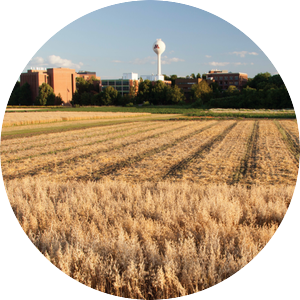
'Climate Solutions: Adaptation in Action' at the Minnesota State Fair
CFANS researchers will showcase innovative climate work,
share key actions for change across urban and rural Minnesota

Climate change can affect the health of individuals and communities in far-reaching ways. Human and animal health, agriculture and food security, transportation, energy, and ecosystems both urban and rural are all anticipated to experience continued disruption in the days ahead. A recent report from the Intergovernmental Panel on Climate Change (IPCC) shows that “climate change is widespread, rapid, and intensifying.”
Researchers at the University of Minnesota’s College of Food, Agricultural and Natural Resource Sciences (CFANS) are tackling this critical issue in our state and around the world with innovative science that will be showcased at the Minnesota State Fair, August 26 — September 6.
“Visitors to our exhibit in the Agriculture Horticulture building will discover a range of research and climate solutions underway at CFANS to help prepare Minnesotans for a changing climate, and learn about climate actions they can take as individuals and communities,” said Heidi Roop, assistant professor of Climate Science in the Department of Soil, Water and Climate, and Extension specialist. Roop and the Minnesota Climate Adaptation Partnership (MCAP) are helping communities prepare for climate risks and delivering critical climate information to all Minnesotans.
The outdoors we love
Minnesotans love the great outdoors year round. But the places we enjoy, including our lakes, are changing with a shifting climate. Freshwater ecosystems and the fish that inhabit them, like walleye, are vulnerable to these changes. CFANS researcher Gretchen Hansen is using innovative techniques to “take the temperature” and track the quality of lakes to understand how climate change is impacting water clarity, ice cover, habitat, and fish populations. Watch a video exploring Hansen's work: Restoring and Protecting Minnesota's Lakes.
Climate and our communities
One of our most used and important resources, water, is of particular concern around the world and in our Minnesota hometowns. When water health declines, the life it sustains can experience ill effects. At CFANS, the Water Resources Center (WRC) is advancing the science of clean water. As Roop explains, climate impacts in Minnesota almost always have a connection to water. “Like many places around the world, water is the great integrator of climate change,” she said.
The food we eat
Minnesota’s agricultural roots run deep. For years, our state’s rich lands have yielded an abundant variety of crops that are central to consumers’ diets here at home and throughout the world. CFANS researcher Yuxin Miao and the Precision Agriculture Center use new technologies to support the environment while maximizing productivity of staple crops.
Our dynamic Minnesota landscape
Northern Minnesota, home of our beloved boreal forests, is a focal point of potential climate warming impacts because it sits at the transition, or ecotone, between the boreal and temperate forest zones. Minnesota’s current climate is similar to what an area 70 miles south of us was like 50 years ago, and may migrate 125 to 250 miles further north over the next 50 years. CFANS researchers are working on a project called B4WarmED (Boreal Forest Warming at an Ecotone in Danger) which seeks to answer, “How will Minnesota tree species respond to a warming climate?”
In addition to exploring climate research, visitors can participate in hands-on, pop-up learning stations featuring a variety of engaging science activities fun for kids and adults alike — as well as take selfies in a custom canoe photo booth. For more information, visit CFANS Climate Solutions: Adaptation in Action.








